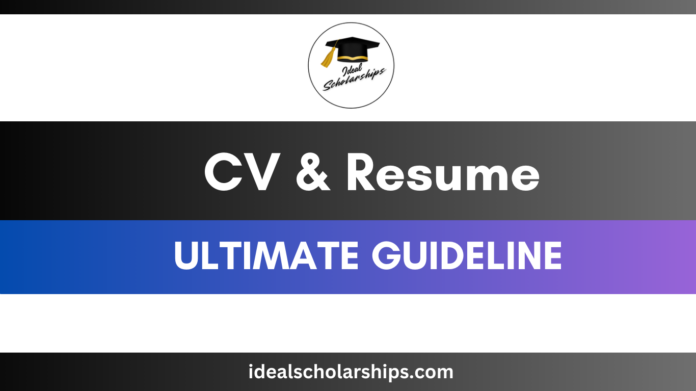In today’s highly competitive job market, how to write a resume and CV effectively can make all the difference in landing your dream job. Whether you’re a student preparing for your first job or a job seeker looking for new career opportunities, understanding the key differences between a resume and a CV is crucial. This guide provides expert tips, templates, and best practices to help you create a professional and optimized document that increases your chances of success.
What is a Resume?
A resume is a concise, one-to-two-page document that highlights your skills, work experience, and education. It is widely used for non-academic job applications in industries such as business, healthcare, marketing, IT, and more.
Key Features of a Resume:
- Length: 1-2 pages.
- Purpose: Provides a quick overview of your qualifications for non-academic roles.
- Audience: Employers in corporate, technical, and creative industries.
- Content: Focuses on work experience, key skills, education, and achievements.
Resume Writing Tips:
Here is how to write a resume:
- Use a clean, professional format: Keep your resume simple, with clear headings and bullet points for easy readability.
- Tailor your resume: Match your skills and experience with the job description.
- Use action verbs: Words like “managed,” “developed,” and “implemented” make a stronger impact.
- Show measurable achievements: Example: “Increased customer engagement by 50% within six months.”
- Optimize for ATS (Applicant Tracking System): Many companies use ATS software, so include relevant keywords from the job posting.
What is a Curriculum Vitae (CV)?
A CV (Curriculum Vitae) is a detailed document used for academic, research, and international job applications. Unlike a resume, a CV provides an in-depth overview of your educational background, publications, research, and professional experience.
Key Features of a CV:
- Length: Typically 2+ pages, but may extend further for professionals with extensive experience.
- Purpose: Highlights academic and research accomplishments.
- Audience: Universities, research institutions, medical fields, and international employers.
- Content: Includes education, work experience, research, publications, presentations, fellowships, and awards.
CV Writing Tips:
Here is how to write a CV:
- Use a structured format: Arrange sections to emphasize your strongest qualifications.
- List experiences in reverse chronological order: Start with the most recent education, research, or work experience.
- Provide detailed information: Unlike a resume, a CV should offer an in-depth look at achievements, publications, and professional activities.
- Customize for the position: Tailor your CV to fit academic or research opportunities.
- Maintain a professional tone: Use precise, formal language.
Resume vs CV: When to Use Each
Choosing between a resume and a CV depends on the type of job or opportunity you’re applying for.
| Resume | CV |
|---|---|
| Used for non-academic positions | Used for academic, scientific, or research positions |
| Typically 1-2 pages | Can be multiple pages |
| Focuses on work experience & skills | Includes detailed academic & research background |
| Preferred in the U.S. job market | Common in academia and international job applications |
| Tailored for industry-specific roles | Used for research grants, fellowships, and faculty positions |
How to Convert a CV into a Resume
If you are transitioning from academia to the corporate world, you may need to convert your CV into a resume. Here’s how:
- Reduce the Length: Condense your CV to 1-2 pages.
- Prioritize Work Experience: Employers in non-academic fields focus on skills and professional experience rather than research publications.
- Use Action Verbs: Make your experience dynamic and impact-driven.
- Emphasize Transferable Skills: Highlight teamwork, leadership, problem-solving, and communication skills.
- Add a Career Objective: Clearly state your career goals and how you fit the job role.
Also visit International Scholarship Opportunities.
Additional Tips: How to write a Professional Resume and CV
- Formatting: Whether creating a resume or CV, ensure the document is clean, organized, and professional. Avoid using excessive fonts or graphics.
- Electronic Versions: When submitting a CV or resume electronically, avoid formatting elements that may not be compatible with applicant tracking systems (ATS). Save your document in a simple, accessible format (e.g., PDF or Word).
- Keywords and Action Verbs: Use industry-specific keywords and action verbs that will catch the attention of both hiring managers and ATS software.
Samples & Examples
Here are some samples and examples for you:
University of Saskatchewan CV Guide
Columbia University Resume Samples
Conclusion
Knowing how to write a resume and CV effectively is key to presenting yourself to potential employers. While a resume is ideal for non-academic positions, a CV is the go-to document for academic, research, and international job applications. By understanding the nuances of both documents and tailoring them to fit the job you’re applying for, you can significantly improve your chances of landing the role you want.
For further assistance, you may want to visit career services websites, seek out industry-specific examples, and consult with mentors in your field to ensure your resume or CV is aligned with the expectations of potential employers.
Also read our Statement of Purpose (SOP) Guide.


